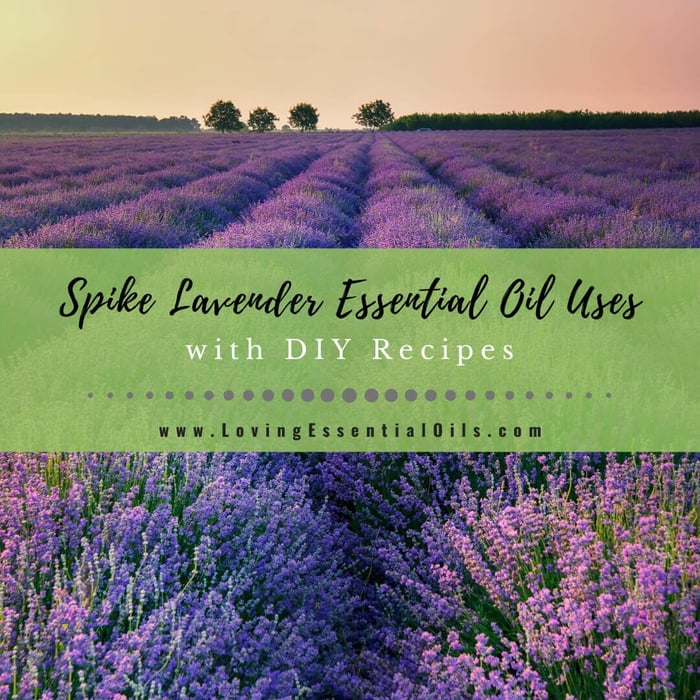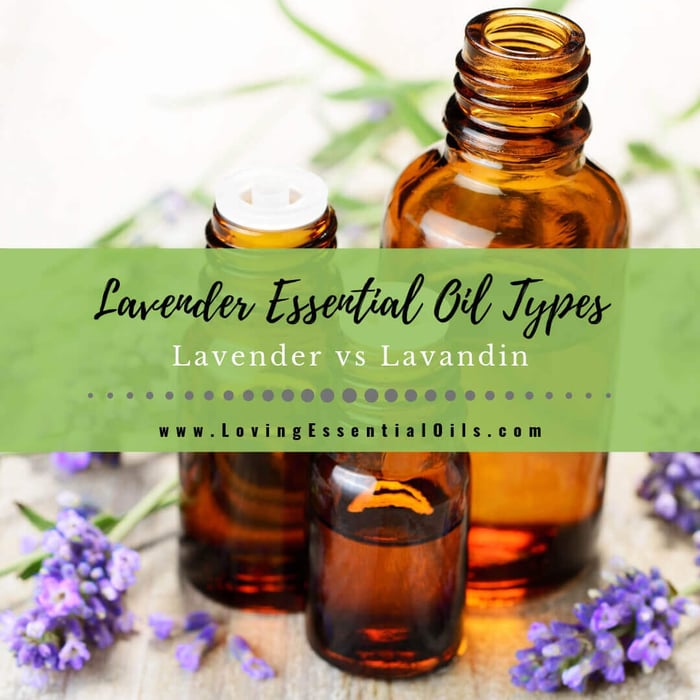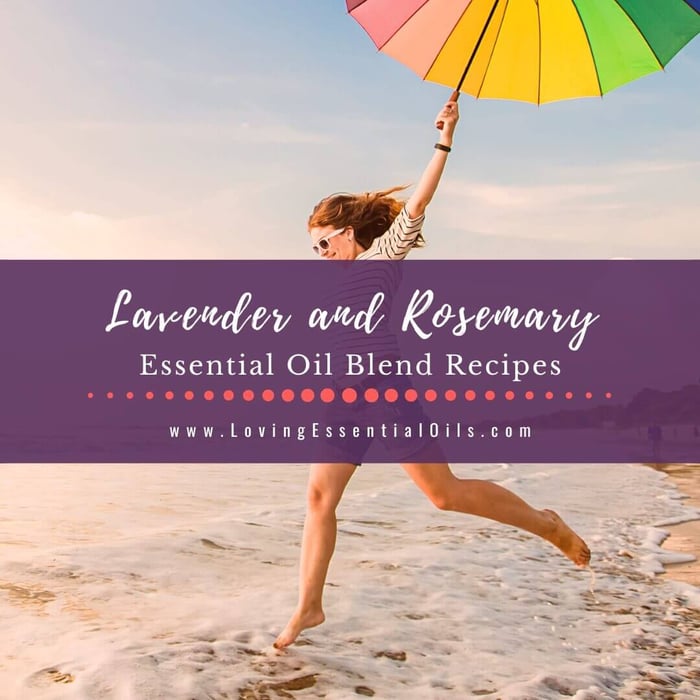Table of Contents
- Spike Lavender vs Lavender Essential Oil - What’s the difference?
- Spike Lavender Essential Oil Spotlight
- Spike Lavender Essential Oil Uses and Benefits
- 5 Spike Lavender Essential Oil Recipes
- Crafting Your Own Aromatherapy Blends With Spike Lavender Essential Oil
- Safety Guidelines For Using Spike Lavender Oil
- Final Thoughts on Spike Lavender Essential Oil Benefits and Uses
- General Essential Oil Precautions
- Frequently Asked Questions About Spike Lavender Oil
Spike lavender essential oil is a true wonder that is often overlooked. It is a different type of lavender oil then the common Lavandula angustifolia, the most popular type used in aromatherapy. In this spotlight, you will learn the uses and benefits of this lesser known lavender oil plus DIY Spike Lavender Essential Oil Recipes you can make at home.
You may want to reach for this oil next time you make a headache relief blend or a diffuser blend for easier breathing. Keep reading to find out why.
From its benefits to how to use it, you'll be able to incorporate spike lavender into your wellness routine in no time!
Spike Lavender vs Lavender Essential Oil - What’s the difference?
Lavender vs spike lavender is a bit of a difficult question to answer, as there is some overlap in their uses and features. Generally speaking, lavender is more commonly used for aromatherapy and as a culinary herb, while spike lavender is more commonly used as an expectorant and for easing aches and pains.
When it comes to their aromas, lavender has a more floral aroma, while spike lavender has a more camphoraceous aroma.
Spike lavender essential oil has a more stimulating and energizing effect than true lavender oil. It encourages concentration and focus better than true lavender as well.

Spike Lavender Essential Oil Spotlight
The flowering tops of Lavandula latifolia are steam-distilled to make Spike lavender essential oil. The oil is clear in appearance and has a floral, herbal scent that is similar to traditional lavendar oil. However, spike lavender contains a large amount of camphor which gives it a camphoraceous smell similar to rosemary or eucalyptus.
True lavender thrives at higher altitudes while spike lavender prefers lower elevations. This difference in environment is why spike lavender has a high level of camphor which is lacking in true lavender. Read more about the types of lavender essential oil.
| Botanical Name | Lavandula latifolia |
| Botanical Family | Lamiaceae |
| AKA | Lesser Lavender, Broad-leaved Lavender |
| Note | Middle |
| Aroma | Floral, fresh, herbaceous, camphorous |
| Extraction Method | Steam distilled |
| Plant Part Used | Flowering tops |
| Shelf Life | 4 years |
| Kid Safe? | Yes |
| Safety Concerns | None known |
Spike Lavender Essential Oil Blends Well With:
There are many oils that Spike Lavender blends well with, this is not an exhaustive list, just some suggestions:
- Basil
- Cinnamon Leaf
- Clary Sage
- Clove Bud
- Cypress
- Eucalyptus
- Geranium
- Grapefruit
- Juniper Berry
- Lemon
- Lemongrass
- Sweet Marjoram
- Silver Fir
- Peppermint
- Pine
- Tea Tree
- Vetiver
- Ylang Ylang
Therapeutic Uses:
Allergies, asthma, bronchitis, bruises, burns, insect repellent, abdominal cramping, headache, depression, dermatitis, throat infections, stress-related conditions, vertigo, muscular aches and pains, dyspepsia, cystitis, insect bites, rheumatism
Therapeutic Properties:
Analgesic, antibacterial, antifungal, antiseptic, decongestant, expectorant, spasmolytic, insect deterrent
Buy Spike Lavender Essential Oil
Here is one brand that we like and use, click picture for more info:
Spike Lavender Essential Oil Uses and Benefits
What is spike lavender oil used for? Spike lavender and lavender share many of the same benefits and uses. It does tend to have a more energizing and stimulating effect than true lavender.
Since spike lavender oil contains a higher percentage of constituent camphor, it has stronger expectorant and analgesic properties. This makes it an ideal choice for relieving headaches and as an expectorant in a diffuser.
It can be applied topically to ease arthritis pains, aches and discomfort. When using essential oils, it is best practice to dilute them in a carrier oil first before applying to the skin. Jojoba and fractionated coconut oil are popular choices.
Here are the benefits of Spike Lavender Essential Oil:
- Strengthens natural energy from within
- Effective insect repellent
- It helps ease aches, pains, and discomfort
- Relieves cough and congestion
- Promotes easy breathing and supports respiratory system
- Assists with reducing the presence of bacterial and fungal growth
- Eases unwanted muscle spasms
- It helps to improve cognitive function and memory
5 Spike Lavender Essential Oil Recipes
Looking for some ways to include spike lavender into your DIY blends? Here are 5 simple yet effective essential oil blend recipes.
1. Calm Energy Roller Blend
Do you ever feel like you're running on fumes? Like your energy level is low and it's hard to focus? If so, this roller blend is for you! The essential oils in this mix are known for their calming and energizing properties. Combined, they can help to boost your energy level and keep you focused throughout the day. Plus, it smells amazing! Give it a try the next time you need an energy boost.
- 2 drops Spike Lavender essential oil
- 2 drops Rosemary essential oil
- 2 drops Peppermint essential oil
- 2 drops Rose Geranium essential oil
- 2 teaspoons Jojoba Oil
- 10 ml Roller Bottle
Directions: Add all recipe ingredients to the roll-on bottle. Shake to blend together, roll onto arms, chest, shoulders, and neck for calming relief. 4% dilution.
2. Lavender Limeade Diffuser Blend
If you're looking for a refreshing and stress-relieving diffuser blend, look no further than this lavender limeade combo. The essential oils in this blend will help to improve your mood and reduce anxiety. So, give it a try today!
- 4 drops Lime essential oil
- 3 drops Spike Lavender oil
- 2 drops Vanilla Absolute
Directions: Add essential oil drops to your aromatherapy diffuser with the recommended water for the tank. Turn diffuser machine on and enjoy.

3. Sinus Headache Inhaler Blend
Do you often get sinus headaches? If so, you're not alone. A sinus headache is a type of headache that is caused by congestion and inflammation in the nasal passages. Symptoms can include a throbbing pain, pressure around the eyes, and a stuffy nose. While there are many over-the-counter medications that can help relieve symptoms, you may want to try a natural approach first. This inhaler blend is designed to help clear congestion and fight infection.
- 5 drops Peppermint
- 5 drops Frankincense
- 5 drops Spike Lavender
- Blank Aromatherapy Inhaler
Directions: Add wick to a small bowl, drop essential oils onto the wick, using tweezers to pick up the wick, then get any oil residual left in the bowl onto the wick. Place the wick in blank inhaler and put on end cap (base). To use, place under nose and inhaler the aroma.
4. Soothing Pain Roller Relief Recipe
Are you looking for a way to relieve pain that doesn't involve medication? If so, you may want to try making your own soothing pain roll on. This is a great way to get relief from tension headaches, neck pain, and other types of pain. Plus, it's easy to make and only requires a few ingredients.
- 4 drops Spike Lavender
- 2 drops Peppermint oil
- 2 drop Blue Tansy
- 2 teaspoons Trauma Oil or jojoba oil
- 10 ml Roller Bottle
Directions: Add all recipe ingredients to the roll-on bottle. Shake to blend together, roll onto the area of discomfort. 4% dilution.
5. Allergy Ease Diffuser Blend for Easier Breathing
- 2 drops Orange
- 2 drops Lemon Eucalyptus
- 2 drops Spike Lavender
- 2 drops Black Spruce
Directions: Add essential oil drops to your aromatherapy diffuser with recommended water for the tank. Turn diffuser machine on and enjoy.

Crafting Your Own Aromatherapy Blends With Spike Lavender Essential Oil
Spike lavender essential oil has many beneficial properties that make it a great addition to aromatherapy blends. Crafting your own aromatherapy blend with spike lavender essential oil can be an enjoyable and rewarding experience.
To start, you’ll need to gather the necessary ingredients. You can use carrier oils such as jojoba, almond, or avocado oil as the base of your blend. You can also use other essential oils like chamomile or lemon balm to create unique aromas and combinations of healing properties.
Depending on the desired effect, you can explore different ratios of each ingredient in your blend.
Once you've gathered all of your ingredients and determined the proportions for your blend, you’re ready to begin creating!
Blending Spike Lavender Essential Oil
Start by adding the carrier oil into a dark-colored glass bottle and then add in each of the essential oils one at a time. Once you’ve added all of the ingredients, screw on the top tightly and shake vigorously for 30 seconds to combine them properly. Your custom aromatherapy blend is now ready to use on your skin!
The combination of spike lavender essential oil with other essential oils adds further therapeutic benefits while enhancing its aroma. Crafting your own aromatherapy blend with spike lavender essential oil is a simple process that yields great rewards!
Safety Guidelines For Using Spike Lavender Oil
Creating an aromatherapy blend with spike lavender oil can be a great way to create a comforting atmosphere. However, it is important to practice safety when using essential oils as they are highly concentrated and potent substances.
Here are some guidelines you should follow when creating aromatherapy blends with spike lavender essential oil:
• Follow the correct dilution rate – Spike lavender essential oil should be diluted in a carrier oil at a 1%-2% concentration. So 6 to 12 drops in 1 ounce of carrier oil of choice.
• Avoid contact with eyes and mucous membranes – Spike lavender essential oil should not come into contact with sensitive areas like eyes or mucous membranes.
• Keep out of reach of children and pets – Essential oils should always be kept out of reach of young children and animals.
Make sure you read up on the safety guidelines for using spike lavender essential oil before embarking on your aromatherapy journey so you can make the most out of it without putting your health or safety at risk.
Final Thoughts on Spike Lavender Essential Oil Benefits and Uses
In conclusion, spike lavender essential oil is a powerful and versatile oil to have in your aromatherapy toolkit. It has a wide range of benefits and can be used as part of many different combinations with other essential oils. When combined correctly, these combinations can provide relief from stress, tension, and even physical pain.
Creating your own essential oil blends with spike lavender can be a fun and rewarding experience that can help you find the perfect blend for relaxation or healing.
However, it’s important to make sure that you are familiar with safety guidelines when using this essential oil so that you don’t cause any harm or damage to your body or skin. With the right knowledge and care, spike lavender essential oil can offer many wonderful benefits for your mind, body, and spirit.
General Essential Oil Precautions
Never use essential oils undiluted, in eyes or mucous membranes. Do not take internally unless working with a qualified practitioner. Keep out of reach from children.
Use essential oils with extreme caution on children, be sure you have researched the oil and that it is safe for use on kids. Plant Therapy clearly labels their oils "KidSafe" on the bottle if the oil can be used for children ages 2–10.
If applying an essential oil topically (on your skin), you may perform a small patch test to an insensitive part of the body, use 1-2 drops in a teaspoon of carrier oil like jojoba oil, read more here.
If you are pregnant, breastfeeding, epileptic, or under a doctor’s care, consult your physician. For more information on oil safety issues here.
Newbie to Oils? Read More: Essential Oils for Beginners

Frequently Asked Questions About Spike Lavender Oil
Find helpful answers to some of the most common questions about this lavender spike essential oil.
How do I use spike lavender essential oil?
Spike lavender oil can be used for multiple purposes such as aromatherapy, massage, skin care, and even for cleaning. You can put a few drops of the oil in your aromatherapy diffuser. Or add to your essential oil massage blends.
What is Spike lavender essential oil good for?
Due to its high camphor content, spike lavender oil is commonly used for respiratory ailments and pain relief. Use on bug bites, belly cramps, allergies, bruises, and so much more. Try in a headache relief essential oil blend with peppermint oil.
What is the difference in smell between lavender oil and spike lavender oil?
The aromas of these lavender and spike lavender are different. When inhaled, spike lavender has a greater camphoraceous aroma than floral. Lavender essential oil is beneficial for so many things, which ever species you choose you will definitely gain benefits.
Is spike lavender essential oil safe for kids?
If you're like most parents, you're always looking for ways to keep your kids safe and healthy. And if you've been using essential oils to help with things like headaches or anxiety, you may be wondering if spike lavender is safe for kids. You will be happy to know that spike lavender essential oil is considered safe for kids ages 2 and up. Get our free PDF list of essential oils for kids.
What is a good essential oil to mix with lavender?
You can pick just about any essential oil and lavender will mix good with it. Scent is a very personal thing but in general citrus essential oils mix well with lavender. You can also try lemongrass, peppermint, rosemary, eucalyptus, or juniper berry.
Share on Pinterest








